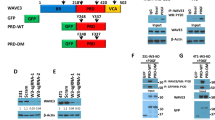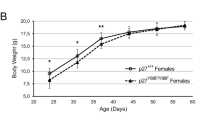Abstract
Transformation by tyrosine kinase oncogenes (TKOs) in myeloid malignancies, including BCR–ABL in chronic myeloid leukemia, FLT3ITD in acute myeloid leukemia or JAK2V617F in myeloproliferative neoplasms, is associated with increased growth and cytoskeletal abnormalities. Using targeted approaches against components of the superoxide-producing NADPH-oxidases, including NADPH oxidase 2 (NOX2), NOX4 and the common p22phox subunit of NOX1–4, myeloid cells were found to display reduced cell growth and spontaneous migration. Consistent with a role of NOXs as regulators of membrane proximal signaling events in nonphagocytic cells, NOX2 and NOX4 were not involved in the excess production of intracellular reactive oxygen species and did not significantly increase oxygen consumption. All NOX family members are controlled in part through levels of the rate-limiting substrate NADPH, which was found to be significantly elevated in TKO-transformed cells. Also, reduced phosphorylation of the actin filament crosslinking protein myristoylated alanine-rich C-kinase substrate (MARCKS) in response to suppression of p22phox hints at a novel effector of NOX signaling. MARCKS was also found to be required for increased migration. Overall, these data suggest a model whereby NOX links metabolic NADPH production to cellular events that directly contribute to transformation.
This is a preview of subscription content, access via your institution
Access options
Subscribe to this journal
Receive 12 print issues and online access
$259.00 per year
only $21.58 per issue
Buy this article
- Purchase on Springer Link
- Instant access to full article PDF
Prices may be subject to local taxes which are calculated during checkout






Similar content being viewed by others
References
Walz C, Sattler M . Novel targeted therapies to overcome imatinib mesylate resistance in chronic myeloid leukemia (CML). Crit Rev Oncol Hematol 2006; 57: 145–164.
Levine RL, Gilliland DG . Myeloproliferative disorders. Blood 2008; 112: 2190–2198.
Banerji L, Sattler M . Targeting mutated tyrosine kinases in the therapy of myeloid leukaemias. Expert Opin Ther Targets 2004; 8: 221–239.
Sattler M, Verma S, Shrikhande G, Byrne CH, Pride YB, Winkler T et al. The BCR/ABL tyrosine kinase induces production of reactive oxygen species in hematopoietic cells. J Biol Chem 2000; 275: 24273–24278.
Wernig G, Gonneville JR, Crowley BJ, Rodrigues MS, Reddy MM, Hudon HE et al. The Jak2V617F oncogene associated with myeloproliferative diseases requires a functional FERM domain for transformation and for expression of the Myc and Pim proto-oncogenes. Blood 2008; 111: 3751–3759.
Sallmyr A, Fan J, Datta K, Kim KT, Grosu D, Shapiro P et al. Internal tandem duplication of FLT3 (FLT3/ITD) induces increased ROS production, DNA damage, and misrepair: implications for poor prognosis in AML. Blood 2008; 111: 3173–3182.
Maulik G, Kijima T, Ma PC, Ghosh SK, Lin J, Shapiro GI et al. Modulation of the c-Met/hepatocyte growth factor pathway in small cell lung cancer. Clin Cancer Res 2002; 8: 620–627.
Sattler M, Winkler T, Verma S, Byrne CH, Shrikhande G, Salgia R et al. Hematopoietic growth factors signal through the formation of reactive oxygen species. Blood 1999; 93: 2928–2935.
Rodrigues MS, Reddy MM, Sattler M . Cell cycle regulation by oncogenic tyrosine kinases in myeloid neoplasias: from molecular redox mechanisms to health implications. Antioxid Redox Signal 2008; 10: 1813–1848.
Andreyev AY, Kushnareva YE, Starkov AA . Mitochondrial metabolism of reactive oxygen species. Biochemistry (Mosc) 2005; 70: 200–214.
Lambeth JD . NOX enzymes and the biology of reactive oxygen. Nat Rev Immunol 2004; 4: 181–189.
Lambeth JD, Kawahara T, Diebold B . Regulation of Nox and Duox enzymatic activity and expression. Free Radic Biol Med 2007; 43: 319–331.
Ambasta RK, Kumar P, Griendling KK, Schmidt HH, Busse R, Brandes RP . Direct interaction of the novel Nox proteins with p22phox is required for the formation of a functionally active NADPH oxidase. J Biol Chem 2004; 279: 45935–45941.
Kawahara T, Ritsick D, Cheng G, Lambeth JD . Point mutations in the proline-rich region of p22phox are dominant inhibitors of Nox1- and Nox2-dependent reactive oxygen generation. J Biol Chem 2005; 280: 31859–31869.
Fernandes MS, Reddy MM, Gonneville JR, Deroo SC, Podar K, Griffin JD et al. BCR-ABL promotes the frequency of mutagenic single strand annealing DNA repair. Blood 2009; 114: 1813–1819.
Holland PC, Clark MG, Bloxham DP, Lardy HA . Mechanism of action of the hypoglycemic agent diphenyleneiodonium. J Biol Chem 1973; 248: 6050–6056.
Yoshie O, Majima T, Saito H . Membrane oxidative metabolism of human eosinophilic cell line EoL-1 in response to phorbol diester and formyl peptide: synergistic augmentation by interferon-gamma and tumor necrosis factor. J Leukoc Biol 1989; 45: 10–20.
Walz C, Crowley BJ, Hudon HE, Gramlich JL, Neuberg DS, Podar K et al. Activated Jak2 with the V617F point mutation promotes G1/S phase transition. J Biol Chem 2006; 281: 18177–18183.
Kim JH, Chu SC, Gramlich JL, Pride YB, Babendreier E, Chauhan D et al. Activation of the PI3K/mTOR pathway by BCR-ABL contributes to increased production of reactive oxygen species. Blood 2005; 105: 1717–1723.
Nisimoto Y, Jackson HM, Ogawa H, Kawahara T, Lambeth JD . Constitutive NADPH-dependent electron transferase activity of the Nox4 dehydrogenase domain. Biochemistry 2010; 49: 2433–2442.
Nisimoto Y, Motalebi S, Han CH, Lambeth JD . The p67phox activation domain regulates electron flow from NADPH to flavin in flavocytochrome b558 . J Biol Chem 1999; 274: 22999–23005.
Nisimoto Y, Ogawa H, Miyano K, Tamura M . Activation of the flavoprotein domain of gp91phox upon interaction with N-terminal p67phox (1–10) and the Rac complex. Biochemistry 2004; 43: 9567–9575.
Babior BM . NADPH oxidase. Curr Opin Immunol 2004; 16: 42–47.
Naughton R, Quiney C, Turner SD, Cotter TG . Bcr-Abl-mediated redox regulation of the PI3K/AKT pathway. Leukemia 2009; 23: 1432–1440.
Ushio-Fukai M . Compartmentalization of Redox signaling through NADPH oxidase-derived ROS. Antioxid Redox Signal 2008; 11: 1289–1299.
Woo HA, Yim SH, Shin DH, Kang D, Yu DY, Rhee SG . Inactivation of peroxiredoxin I by phosphorylation allows localized H2O2 accumulation for cell signaling. Cell 2010; 140: 517–528.
Suh YA, Arnold RS, Lassegue B, Shi J, Xu X, Sorescu D et al. Cell transformation by the superoxide-generating oxidase Mox1. Nature 1999; 401: 79–82.
Mochizuki T, Furuta S, Mitsushita J, Shang WH, Ito M, Yokoo Y et al. Inhibition of NADPH oxidase 4 activates apoptosis via the AKT/apoptosis signal-regulating kinase 1 pathway in pancreatic cancer PANC-1 cells. Oncogene 2006; 25: 3699–3707.
Yamaura M, Mitsushita J, Furuta S, Kiniwa Y, Ashida A, Goto Y et al. NADPH oxidase 4 contributes to transformation phenotype of melanoma cells by regulating G2-M cell cycle progression. Cancer Res 2009; 69: 2647–2654.
Arbuzova A, Schmitz AA, Vergeres G . Cross-talk unfolded: MARCKS proteins. Biochem J 2002; 362: 1–12.
Sattler M, Quinnan LR, Pride YB, Gramlich JL, Chu SC, Even GC et al. 2-Methoxyestradiol alters cell motility, migration, and adhesion. Blood 2003; 102: 289–296.
Thomas EK, Cancelas JA, Chae HD, Cox AD, Keller PJ, Perrotti D et al. Rac guanosine triphosphatases represent integrating molecular therapeutic targets for BCR-ABL-induced myeloproliferative disease. Cancer Cell 2007; 12: 467–478.
Acknowledgements
This work is supported in part by National Institutes of Health Grants (5R01CA134660-03, MS), (5R01CA129501-02 and 5R01CA125541-03, RS) and (5P01CA66996-12, JDG), a Leukemia and Lymphoma Society SCOR grant (JDG) and by grants from the American Cancer Society, the US Department of Defense and the Adams Barr Program in Innovative Cancer Research (MS).
Author information
Authors and Affiliations
Corresponding author
Ethics declarations
Competing interests
The authors declare no conflict of interest.
Additional information
Supplementary Information accompanies the paper on the Leukemia website
Rights and permissions
About this article
Cite this article
Reddy, M., Fernandes, M., Salgia, R. et al. NADPH oxidases regulate cell growth and migration in myeloid cells transformed by oncogenic tyrosine kinases. Leukemia 25, 281–289 (2011). https://doi.org/10.1038/leu.2010.263
Received:
Revised:
Accepted:
Published:
Issue Date:
DOI: https://doi.org/10.1038/leu.2010.263
Keywords
This article is cited by
-
Context-specific effects of NOX4 inactivation in acute myeloid leukemia (AML)
Journal of Cancer Research and Clinical Oncology (2022)
-
Pathophysiological roles of myristoylated alanine-rich C-kinase substrate (MARCKS) in hematological malignancies
Biomarker Research (2021)
-
Tetrahydrobenzimidazole TMQ0153 triggers apoptosis, autophagy and necroptosis crosstalk in chronic myeloid leukemia
Cell Death & Disease (2020)
-
Reactive oxygen species in haematopoiesis: leukaemic cells take a walk on the wild side
Journal of Experimental & Clinical Cancer Research (2018)
-
Expression of oxidized protein tyrosine phosphatase and γH2AX predicts poor survival of gastric carcinoma patients
BMC Cancer (2018)



